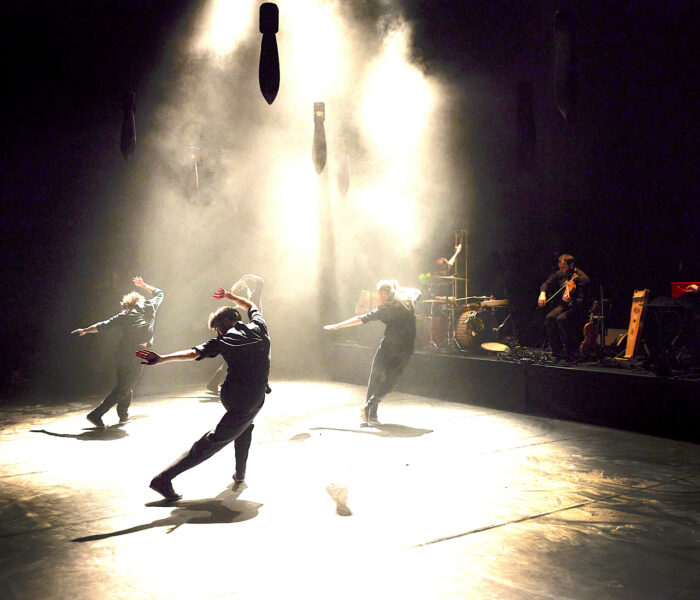De la rencontre entre Amaury Cornut et Stéphane Garin de l’ensemble 0 est née la folle idée de ressusciter Elpmas dans une version scénique, sous forme mi instrumentale mi électronique. Cet album a été composé en 1991 par Moondog avec les ordinateurs et les samples d’Andi Toma, la moitié du duo electro Mouse on Mars. Sorti en 1992, ce disque se présentait comme une ode écologique à la nature et au cosmos, tout en prenant la défense des aborigènes. Andi Toma avait réussi à convaincre Moondog, pourtant très attaché aux instruments acoustiques et aux interprètes humains, que la complexité et la rigueur de ses canons trouveraient une réalisation idéale dans la régularité implacable des ordinateurs. Le projet de l’ensemble 0 s’est révélé encore plus ambitieux avec la sortie d’un livre-disque magnifique, “Elpmas’ (Moondog) revisité/revisited, sorti en 2018 chez Murailles Music, Ici d’ailleurs et Super Loto Editions.
Amaury, peux-tu nous détailler le projet scénique Elpmas avec l’Ensemble 0 ?
Amaury Cornut : L’idée est née de ma rencontre avec Stéphane Garin lors d’une Folle Journée à Nantes, il y a de ça de nombreuses années. Il est percussionniste d’une part, et passionné de techno d’autre part. Elpmas s’imposait alors comme une évidence. Il fallait faire exister cette musique sur scène, ce qui était un défi, car c’est un pur album de studio. Moondog, avec l’aide d’Andi Tomas de Mouse on Mars, avait échantillonné une à une toutes les notes d’un marimba pour créer des canons par ordinateur. Il pensait qu’il était, sinon impossible, vraiment trop compliqué de trouver des musiciens capables de jouer aussi froidement et sans la moindre fausse note les canons sinueux qui composent ce disque. Nous avons fait le pari contraire, en montant tout d’abord une version initiale à six instrumentistes, avec Julien Pontvianne, qui peut assurer toutes les parties de sax et de clarinettes, Joël Merah, qui a mis au propre les 237 pages de partitions à partir de mes archives et a repiqué intégralement en bonus un morceau dont je n’avais pas la partition, des percussionnistes tout terrain et Vincent Malassis en maître de cérémonie, qui travaille les bandes en live. Il y a également la complicité d’un ingénieur son qui gère les samples, car dans Elpmas, qui se lit « sample » à l’envers, il est nécessaire d’user d’échantillons même en live, car il est impossible d’avoir seize joueurs de marimbas sur scène. S’ajoute à l’ensemble une ingénieure lumière qui a imaginé des tableaux visuels pour chaque morceau.
Cette équipe initiale a-t-elle évolué ?
Au début, nous utilisions des samples originaux envoyés par Andi Toma pour les partitions de viole de gambe, comme si les fantômes du disque d’origine étaient à nos côtés sur scène. Ils ont depuis été remplacés par Barbara Hünninger, pour notre plus grand plaisir. Toutes les parties chantées ont été réenregistrées également, les leads sont assurés par Jonathan Seilman et Vanille Fiaux. Désormais, quatre des chanteurs du Macadam Ensemble sont sur scène avec nous, après avoir enregistré les chœurs pour le disque. Rodolphe Alexis a enregistré des field recordings qui correspondent parfaitement aux ambiances du disque d’origine. Tomoko Sauvage avait, dans un autre cadre, prêté sa voix à la lecture d’un poème qui introduit une pièce du disque : nous avons utilisé cette bande avec son autorisation. La version actuelle compte donc onze musicien.ne.s sur scène.
Stéphane, peux-tu nous résumer les principales étapes de ce projet ?
Stéphane Garin : Comme tout bon projet qui se respecte, cela a commencé de manière totalement informelle autour d’un bon repas entre moi, Amaury et Cyril Jollard, qui était alors programmateur et créateur du superbe festival Variations à Nantes. La chose était excitante, car elle permettait d’envisager une lecture de cet album que nous pourrions d’une part amener sur scène, mais également réenregistrer en usant exclusivement d’instruments acoustiques. Puis, le travail s’est organisé avec la contribution précieuse de Murailles music pour la production et l’organisation de résidences. Je me suis pour ma part occupé de réunir les troupes, quand Joël Merah s’occupait de l’arrangement/réorchestration de la musique originale de Moondog.
Nous nous sommes aperçus que cet album ne pouvait être joué en direct sur scène avec l’effectif au complet. Par exemple, le Pow-wow du départ déploie 25 parties de marimbas en canons. Aussi, nous avons dû user de samples diffusés sur scène, au sein desquels les musiciens au plateau doivent se déployer. C’est là qu’entre en jeu le travail de Guillaume au son, qui positionne les enceintes au plateau et les équilibres acoustiques entre diffusion et live, et celui de la lumière d’Azeline.
Pouvez-vous également décrire ce très bel objet, le coffret de disques/livre Elpmas ?
Amaury Cornut : Le disque originel n’existe que sous la forme d’un CD en boitier plastique, accompagné d’un livret. Puisque nous ramenions de l’humain et de l’organique dans notre version, en opposition au caractère machinique de l’original, nous avons également voulu un contre-pied à la version digitale avec cette version vinyle, et donc analogique. Nous avons intégralement réenregistré toute la matière : il ne s’agissait pas de mettre sur vinyle un support prévu initialement pour un support numérique ! Assez vite, il a été question d’un livre-disque en coédition entre Murailles Music, Ici d’ailleurs et Super Loto Editions. Ça a conditionné le format d’un double vinyle de 10″ avec un livre d’art de 84 pages contenant quatre textes confiés à quatre auteurs, autour des grands thèmes qui composent Elpmas : la pulsation, le voyage, la nature et le cosmos. J’ai signé une courte préface qui pose le contexte de ce disque. Nous avons choisi les auteurs avec Super Loto Editions, qui s’est occupé de la partie livre. Ça offre des approches très différentes d’un même objet. Même principe pour les visuels, avec cette fois deux artistes par thème, sélectionnés par SLE également.
Stéphane Garin : C’est juste le plus beau disque que j’ai fait jusqu’alors : une sorte d’objet de production suicidaire, au vu de l’état du marché de la musique aujourd’hui. Mais je crois qu’il aura une longue vie, car il est d’une grande qualité et qu’il respecte celui qui décide de le posséder. C’est un travail visuel de qualité qui réunit dix dessinateurs, un très beau tirage, un mastering de haute volée, assuré par David Chalmin, un enregistrement irréprochable par Benjamin Maumus et le soutien précieux du GMEA (Didier Aschour).
Amaury, pour ce projet, tu as également convoqué les talents de Vincent Malassis, qui interprète une composition électronique personnelle pour le dernier quart d’heure du concert, un moment planant, hors du temps, presque rituel. Quels sont les raisons de ton choix ?
Amaury Cornut : Ma complicité avec Vincent date de 2012. Il avait alors développé une composition pour bandes magnétiques déjà inspirée du « Cosmic Medidation » de Moondog. C’est cette même base qu’il a développé pour arriver à ce moment que tu décris. Même si, contrairement au reste de l’équipe, Vincent n’a pas de connaissances musicales académiques, c’est un vrai musicien au même titre que les autres : c’est un vrai platiniste, il maîtrise parfaitement le sampling, et n’est-ce pas le cœur d’Elpmas après tout ? Quand j’ai proposé Vincent à Stéphane Garin, ce dernier a partagé mon sentiment. Il fallait transformer « Cosmic Meditation » en quelque chose d’autre, et c’est effectivement le seul moment de liberté que nous nous sommes offert par rapport au disque originel. Si j’aime beaucoup écouter l’original au calme dans mon salon, il me semblait peu intéressant de terminer un set aussi riche avec cette pièce vraiment très ambient. Il n’était cependant pas question de changer l’ordre de la track list, nous voulions terminer avec cette longue pièce. Je la considère comme une digestion de tout ce qu’il s’est passé pendant une heure. Pour moi, l’original a cette faculté de brouiller les repères temporels, et si tu trouves que le rendu est « hors du temps », alors c’est mission accomplie !
Vincent, quelle est la raison de ton intérêt pour Moondog ?
Vincent Malassis : Amaury m’avait envoyé des schémas de compositions de Moondog, des portraits représentant le passé et le futur. Son travail sur le temps m’a fasciné, et comme j’ai l’habitude de travailler avec des boucles et leurs décalages, le contrepoint me parle donc bien, de même que la complexité des signatures rythmiques, qui paradoxalement sont si évidentes sur ses belles mélodies, qui semblent simples et que l’on chantonne directement. J’écoute Moondog depuis un certain temps et sa musique me nourrit, c’est une chance d’avoir pu décortiquer un disque complet pour essayer de comprendre cet artiste.
Quel est ton rôle dans le cadre des prestations scéniques avec l’Ensemble 0 ?
V.M. : Elpmas est rempli de field recording et d’ambiances sonores issues des voyages de Moondog. J’ai gravé les bandes sur vinyle. J’utilise la platine comme un instrument, ce qui me permet de moduler les sons et de les envoyer dans des effets. Pour la fin du concert, j’ai composé deux pièces qui s’enchaînent en m’inspirant des deux derniers titres de l’album : « Introduction And Overtone Continuum » & « Cosmic Meditation ». Les boucles s’enrichissent dans de la distorsion, des bandes magnétiques, réverbération, delay et réinjections (feedback), ça passe de l’ambiant bien planant à de la noise bien mentale, que je dose sur table de mixage.
Stéphane, je crois qu’il y a eu avec Elpmas des moments particulièrement forts, comme vos performances à New York, une des villes de résidence principales de l’artiste. Tu y as fait de belles rencontres. Peux-tu nous en dire plus ?
Stéphane Garin : Je me souviens d’une personne très belle, d’environ 75 ans, qui m’a raconté qu’alors qu’elle venait d’avoir un travail au MOMA à New York dans les années 50, elle croisait chaque jour le Viking de la 6e avenue en allant et en repartant du bureau. Elle a décidé un jour de lui parler, puis est devenue son amie. C’était assez émouvant qu’elle me raconte cette histoire le 21 juin, alors qu’elle était venue spécialement nous voir jouer pour célébrer la musique de Moondog.
Et justement cette performance dans la rue, filmée le 21 juin 2019 par Derrick Belcham, sur les traces de Moondog ?
SG : Le projet était que la musique devait tenir dans la rue et dans nos valises. Nous avons choisi quelques compositions que nous avons humblement tenté d’interpréter expérimentalement, comme Moondog devait le faire à son époque.
J’ai proposé Jean-Brice Godet surtout pour son travail autour de la cassette, qui amenait un angle lo-fi au projet. Thomas Bonvalet était là dès le départ, et Alexis Degrenier n’a pu nous rejoindre pour des raisons de santé. Ce moment éphémère n’existe plus et n’a existé que durant les mois de mai et juin 2019.
Propos recueillis par Guillaume Kosmicki



)



